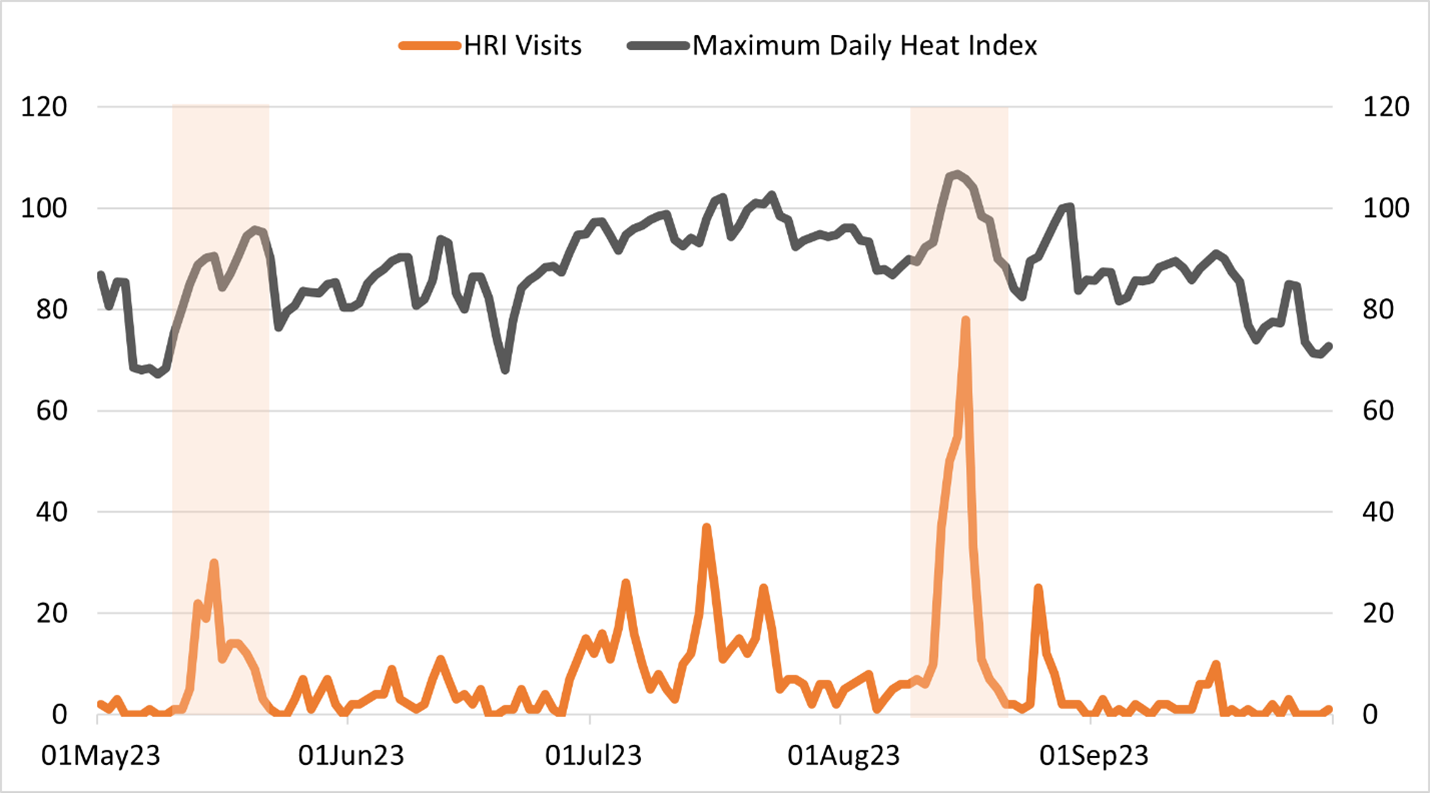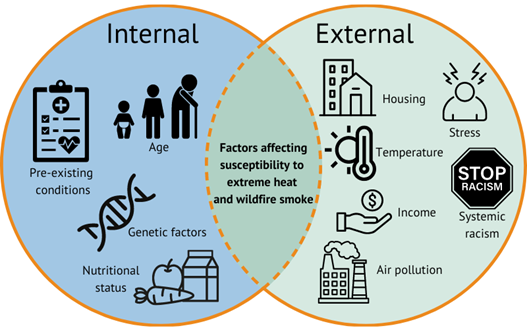Building resilience: How Oregon tackles extreme weather's health risks
10/18/2024
Extreme weather in Oregon: A call for climate resilience
Oregon's climate isn't what it used to be. Summers are hotter, wildfires are more intense, and droughts seem to stretch on forever. These extreme weather events are our new normal, and for most of us the most striking impacts of climate change. They bring a wave of challenges that affect the health of our families and communities and deepen existing health inequities. This means the people most impacted by racism, poverty, and prejudice are also hit the hardest by extreme weather.
Our 2023 annual
Climate and Health in Oregon Report shows how these climate threats facing our state affect the health of people who live here.
Read the full report:
2023 Climate and Health in Oregon Report.
Human impacts and human-centered solutions
These climate threats aren't just about rising temperatures—they're about real people facing real health risks:
- Heatwaves endangering the lives of community members, especially older adults living alone and with low incomes.
- Wildfire smoke polluting our air, leading to a spike in asthma and heart problems.
- Droughts threatening our water supply, making clean drinking water harder to come by.
If you've been through a wildfire or had another extreme weather event hit close to home, this can be hard to read. It's personal. Sometimes, knowing what's coming helps, as well as having a role in the solution. This blog will both describe the health harms of extreme weather in Oregon and talk about what we can do to support a healthy future.
The good news is that we can work together to support community health in the face of these challenges.
Coming together to build resilience to extreme weather events
To tackle these challenges, we've teamed up with partners across the state—from community-based organizations to local health authorities. Together, we're building a resilient public health system that's ready for whatever mother nature throws our way.
Our long list of partners includes:
- Local public health authorities (LPHAs)
- Community based organizations (CBOs)
- Regional coalitions
- Health care and behavioral health providers
- Public safety agencies
- Faith-based institutions
- Schools
- Environmental agencies
- The business sector
Together, we're building climate resilience by:
-
Responding to and preparing for health impacts: More frequent wildfires, heat waves and other extreme weather events are challenging our health systems like never before.
-
Planning for chronic health stressors: Poorer air or water quality have cascading impacts on mental health, food, access to healthcare, housing, income, transportation and other aspects of well-being.
-
Leading with equity: We are working to address the health, social and economic systems that contribute to making certain communities more vulnerable to climate-associated health risks.
Read on to learn how climate is challenging our communities, and what we can do about it.
Extreme heat: The health impacts of rising temperatures
If you've noticed that summers feel hotter than they used to, you're not alone. The year 2023 was the hottest on record globally. In Oregon, extreme heat events—those days when temperatures soar above normal—are happening more often and with greater intensity.
Here's the reality:
-
June 2021: An extreme heat event hit the Pacific Northwest, leading to 102 deaths, mostly among isolated, low-income older adults.
-
Rising temperatures: This trend isn't going away. As temperatures rise, so does the risk of heat-related illnesses and deaths.
Daily heat-related illness emergency department and urgent care visits and maximum daily heat index in Oregon, May-September, 2023.
Air quality: The health impacts of wildfire smoke
Wildfires are becoming larger and more severe, creating smokier air that can impact Oregonians' lung health and heart health.
The facts:
-
Respiratory health: In 2023, respiratory illness rates in some Oregon communities were nearly double the state average due to poor air quality. The following communities faced the most extreme impacts:
- American Indian/Alaska Native
- Black/African American
- Native Hawaiian/other Pacific Islander
-
Long-term impact: The particles in wildfire smoke can cause both immediate and long-term health issues, including asthma and heart attacks.
These numbers aren't just statistics – they represent real people struggling to breathe.
Factors affecting susceptibility to extreme heat and wildfire smoke.

Water security: When the wells run dry
Across Oregon, more frequent and severe droughts, floods and growth of toxin-producing algae in water are threatening our water security—the ability to access clean, safe and affordable water.
Key concerns:
-
Drought: In 2023, 52 percent of Oregon experienced severe drought, with 30 percent facing extreme conditions.
-
Waterborne diseases: Rising temperatures and water scarcity are creating perfect conditions for diseases like Lyme Disease and West Nile Virus to spread.
Mental health: The hidden toll
While physical health impacts are more visible, the mental health toll of climate change is just as real. This can look like anxiety about the future or the trauma of losing homes and livelihoods to wildfires.
What we're seeing:
-
Youth anxiety: The
2022 Climate Change and Youth Mental Health Report revealed that many young people in Oregon are struggling with feelings of hopelessness and despair about the future.
-
Community impact: Extreme weather events are leading to increased rates of anxiety, depression and post-traumatic stress disorder (PTSD).
Oregon youth reporting feelings of anxiety, frustration and hopelessness about the future is a sobering reminder that extreme weather affects us all, in ways both seen and unseen.
Building resilience: Our path forward
Over the past several years, we've developed a resilience framework that's all about relationships—between public health, housing, healthcare, forestry, land use and community partners. This isn't just about physical infrastructure; it's about people and the connections that make our communities stronger.
Oregon Public Health Modernization funding is the backbone of this effort, providing resources that organizations need to build these vital relationships, innovate and work together toward a common goal of climate resilience.
Here is how the work is playing out across our state.
Community-based organizations: The heart of resilience
Supported by health modernization funding, community-based organizations (CBOs) across Oregon are stepping up to meet climate challenges head-on.
Spotlight:
Many CBOs have also partnered with LPHAs to respond to extreme weather events. In 2020 and 2021, Northwest Family Services and Clackamas County Public Health Division helped residents evacuate from wildfires. In 2022 and 2023, they expanded their efforts to distribute air-conditioning (AC) units to those in need—providing not just relief from the heat, but a lifeline. Learn more about the partnership in this video:
Northwest Family Services and Clackamas County Public Health Division partnership video
Local public health authorities: On the front lines
Local public health authorities (LPHAs) are crucial in this fight, working with partners to create action plans tailored to their communities.
Spotlights:
Tribal communities: Protecting heritage and health
For Oregon's nine federally recognized tribes, modernization funding is helping to preserve both health and cultural heritage.
Initiatives:
Oregon Health Authority: Supporting resilient communities
At OHA, we are centering equity in our efforts to modernize statewide public health infrastructure. This includes investments in climate equity, healthy homes and schools, land use and health, healthy waters, and epidemiology (the study of how health outcomes affect populations and why).
A few of our initiatives:
-
Grant funding: Programs like
the Healthy Homes Grant Program help low-income households and those impacted by environmental justice factors equip their homes to withstand environmental hazards like harmful air quality and extreme heat.
-
Air conditioner and air filter distribution: We also administer a program to distribute
air conditioners and air filters to Oregonians in need, helping them protect themselves from extreme heat and wildfire smoke.
OHA leads the state with investments in climate resilience, funding and technical support to our public health partners, and data tracking systems related to climate and health. These supports are not always the most visible, but we believe they are vital. They lay the foundation for our partner organizations as they innovate and work together toward a common goal of climate resilience.
Partnering for a healthier future
Addressing the impacts of extreme weather on public health is a critical priority for Oregon's public health system. By working together—through proactive measures and strong community partnerships—we can protect the health and well-being of all Oregonians. Continued investment in public health modernization is essential to meet these challenges head-on and ensure a healthier future for our state.
Make a difference in Oregon
You can be part of this journey. Here's how:
- Subscribe to our e-newsletters for updates on public health initiatives.
- Share this information on social media to spread awareness.
- Get involved: Support local public health initiatives and policies.
Through resilience and collaboration, we can face Oregon's climate challenges together - ensuring a safe, healthy and equitable future for all.